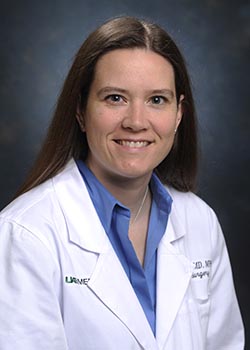 A nondirected donor is someone who is committed to being a living kidney donor but does not have an intended recipient. The 13-person chain began in December as the result of the selfless act of a nondirected living kidney donor, Helena-native Paula Kok, and was scheduled to continue the week of Jan. 27 with 16 operations — eight donor nephrectomies and eight kidney transplants.
A nondirected donor is someone who is committed to being a living kidney donor but does not have an intended recipient. The 13-person chain began in December as the result of the selfless act of a nondirected living kidney donor, Helena-native Paula Kok, and was scheduled to continue the week of Jan. 27 with 16 operations — eight donor nephrectomies and eight kidney transplants.Many of the recipients and donors braved icy, hazardous roads and below-freezing conditions to reach UAB. Surgeons, nephrologists, nurses and support staff spent three days and nights in the hospital to ensure the success of the chain and give the gift of life. On Friday, Jan. 31, 15-year-old Decatur, Miss., Ryane Burns became the 13th person to receive a kidney transplant.
These 13 patients, with a new lease on life, were the product of a unique set of circumstances. First was Kok’s willingness to consider donating a kidney to a stranger in need. Her desire led her to the South’s leading incompatible kidney transplant program, at UAB, the outgrowth of efforts spanning 45 years and almost 10,000 transplants.
Ryane’s transplant signifies Children’s of Alabama as the only program in the Southeast to offer kidney paired donation to those younger than 18.
“This kidney chain is a groundbreaking achievement for our institution and a life-changing event for many families throughout the southeastern United States, especially these 13 families involved,” said Devin Eckhoff, M.D., director of UAB’s Division of Transplantation. “Our collaboration with Children’s of Alabama in this endeavor ensures that the people of Alabama and beyond have a team of physicians, nurses, researchers and staff who are dedicated to working together to provide the most advanced care in the world, right here in our own backyard, to those in need.”
A nondirected donor chain like this creates numerous, otherwise unavailable opportunities for recipient-donor pairings. The first nondirected donor gives to a recipient with a willing but immunologically incompatible living donor. A chain reaction then ensues in which the “bridge donor” then gives to the next incompatible recipient-donor pair, essentially paying the initial donor’s gift forward.
“This success is the culmination of almost a decade of effort at UAB to bring this capability to the people of Alabama and the Southeast,” said Robert Gaston, M.D., the Robert G. Luke, M.D., Endowed Chair in Transplant Nephrology in UAB’s School of Medicine. “It reflects the hard work of many, and hopefully can be repeated many times in the months and years to come. Many programs offer living donor kidney transplantation, but require that a completely compatible match be found. We have the ability to use our paired exchange and incompatible transplant programs in tandem to identify and connect potential living donors with recipients who have no other options, multiplying the number of successful transplants that can be performed.”
This past year marked the beginning of a new era for UAB, with almost 30 such transplants performed that would not have been possible otherwise.
“This January event is in many ways the kickoff of what promises to be an even more eventful 2014, emphasizing how much benefit can result from the selfless act of the initial generous donor,” Gaston said.
UAB’s incompatible program is the only one of its kind in the Southeast, offering pretreatment to overcome blood group and/or HLA incompatible barriers, coupled with kidney paired donation options to reduce incompatibility and facilitate less challenging transplants.
“Development of the incompatible kidney transplant program at UAB has been a remarkable team effort, and its success is due in large part to the dedication of our surgeons, transplant nephrologists, transplant operating room team and nurses,” said Jayme E. Locke, M.D., surgical director of the Incompatible Kidney Transplant Program. Their efforts prior to this chain have been vital, particularly those of Vineeta Kumar, M.D., medical director of the Incompatible Kidney Transplant Program, and Vera Hauptfeld, Ph.D., director of the Histocompatibility Laboratory. There is a tremendous amount of time devoted to helping incompatible donor-recipient pairs realize kidney transplantation. It is a delicate process that is made possible only by the knowledge and dedication of our entire transplant team.”
“The coming together of multiple disciplines working continuously and cohesively to make this happen despite the adverse climatic conditions embodies the spirit of medical care provided at UAB,” Kumar said.
The nondirected donor chain is scheduled to continue in March with five more kidney transplants. Jason Burns, Ryane’s father, is the bridge donor.
To become a living kidney donor, visit uabmedicine.org/kidneytransplant, or to indicate your interest in donating your organs after death, visit www.organdonor.gov/index.html and sign up today.